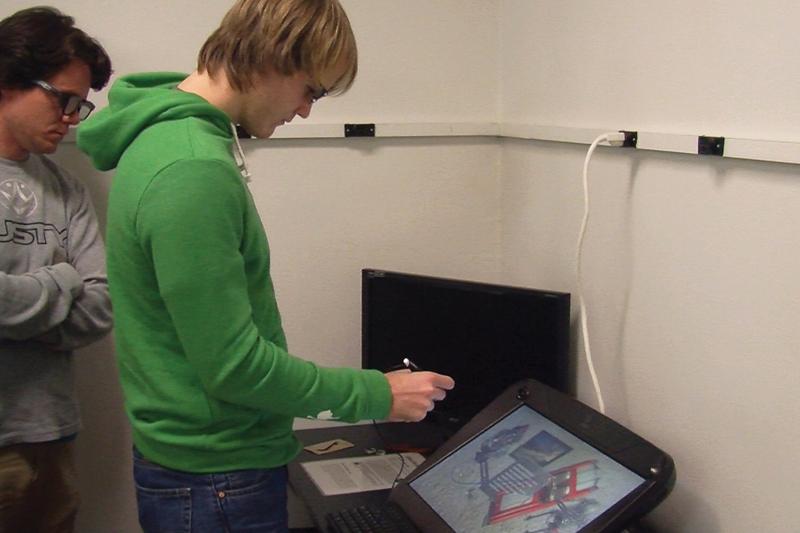
Michael Price/ The Collegian
Fresno State’s geomatics engineering program is moving into the future with a 3-D technology called zSpace.
With zSpace, students use a stylus to manipulate and control three-dimensional images. They have to use specially designed, $500 3-D glasses with five points of reference to help track the image. Onlookers use glasses just like the kind one would get at a traditional 3-D movie.
This new technology came to the university due in large part to Riadh Munjy, doctor of geomatics engineering and program coordinator, and contributions from donors. Engineering East Room 101 was able to update its photogrammetry equipment.
The purpose of the photogrammetry lab is to let geomatics engineering students take measurements based off of 2-D images.
“Well the whole idea basically in geomatics, we would like to do measurements,” Munjy said. “We do measurements using GPS equipment. We do measurements taken from picture from airplanes, from satellites, even pictures in the water, so anything that we can measure and can produce data in X-Y-Z. We would like to visualize and try to measure to access the accuracy of that equipment.”
Munjy said there are a variety of potential uses for this type of 3-D technology beyond simple entertainment. He cited three-dimensional surgery as a way that students can acquire experience applicable to their career paths.
In the medical field, for example, the equipment and techniques need to be precise, which the zSpace program tries to replicate to provide the best model possible.
“The tolerance is very, very small,” Munjy said. “He (a student using the technology) can not afford to make mistakes that large, so the student has to be very careful how to take these pictures and how to put them together, so that final results are acceptable to a medical doctor in that case.”
Grady Roth is a senior in the geomatics engineering department. He said there are many ways that different majors can make use of zSpace.
“You’ll see that there’s a house you can explore, so construction,” Roth said. “I just picked up a part of some sort, a mechanical engineering kind of thing designed like that. You can do bridges as well””civil engineering.
“The way our major ties in with all that is we do the measurements for all that as well as the 3-D aspect with this (the equipment). We learn the math and how to create these three-dimensional images.”
Munjy said that he has had students from other disciplines who have taken an interest in using this new technology for their own non-engineering majors.
“There has been some interest from computer science students to come and make their senior projects,” he said, “because the equipment we have is very unique and everybody is interested to get their hands on it.”
For students to get access to zSpace they need to enroll in the corresponding upper-division geomatics engineering class. It is not a class you can simply enroll in though. The class relies heavily on linear algebra, so there are a variety of necessary math prerequisites just to get into the class.
“We are not only interested in the pictures, but the math behind them,” Munjy said. “We spend quite a bit of math and quite a bit of introductory courses to get them to where they are supposed to be.”
A point of pride for Munjy is that the money used to buy the equipment did not have to come from the university.
“All the equipment that you see over here, not a cent came from the state. It all came from private donations,” Munjy said. “For the hardware, we were able to get money. And all the software, what we couldn’t buy was donated. I have 14 computers, each with 32 gigabytes of RAM. Each one has about $25,000 software on each computer minimum.”
Munjy said the equipment update was necessary, because the previous hardware was older than most of the students.
“If you had come a year and a half ago, what you would have seen is a room full of equipment from the ’40s, ’50s and ’60s era; maybe one or two machines from the ’70s and one from the ’80s,” he said.
Munjy said that everyone affiliated with the university should be proud to have such a unique and state-of-the-art lab on campus. It is one of the few programs of its kind in the nation.
“I think it’s one of the unique labs in the nation now,” Munjy said. “Everybody’s proud of it. The students are very enthusiastic, and they are very excited and eager to use the equipment and get more knowledge out of the systems.”





